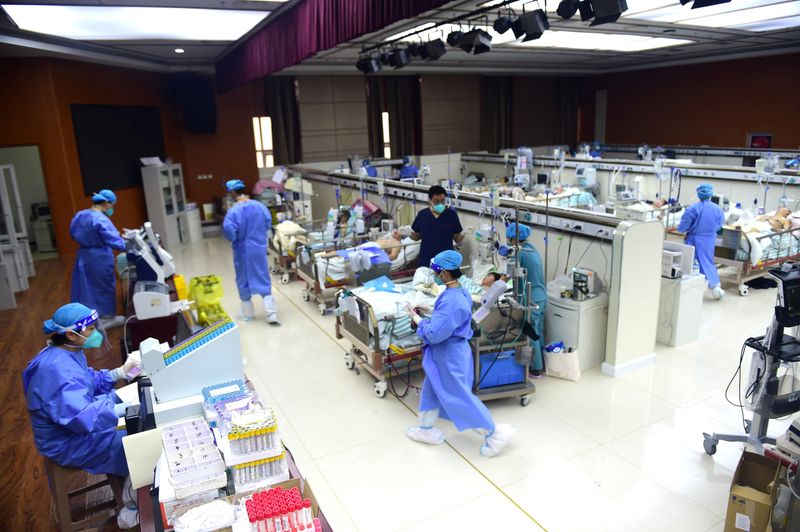COVID covers China
2023.01.13 02:12

COVID covers China
Budrigannews.com – A leading Chinese epidemiologist has stated that the COVID-19 peak in China will soon spread across the vast countryside, where medical resources are scarce, and will last two to three months.
As hundreds of millions of people travel to their hometowns for the Lunar New Year holidays, which officially begin on January 21 and were the world’s largest annual migration prior to the pandemic, infections are anticipated to rise in rural areas.
China reopened its borders on Sunday after abruptly abandoning the strict anti-virus regime of widespread lockdowns that fueled historic protests across the country in late November.
According to state media, more than a third of China’s 1.4 billion people live in areas where infections are already past their peak due to the abrupt removal of restrictions.
According to a report that was published on Thursday in the local media outlet Caixin, Zeng Guang, the former chief epidemiologist at the Chinese Center for Disease Control and Prevention, warned that the worst of the outbreak was not yet over.
“The major cities have been our primary focus. Zeng was quoted as saying, “It is time to concentrate on rural areas.”
He stated that a significant number of the elderly, ill, and disabled are being left behind in the rural areas with inadequate medical facilities.
Authorities have stated that they are working to increase the supply of antivirals across the nation. Molnupiravir, a COVID treatment from Merck & Co., is expected to be available in China starting on Friday.
This week, the World Health Organization issued a warning regarding the dangers associated with vacation travel.
Despite the fact that China is now providing more information regarding its outbreak, the UN agency stated that China was significantly under-reporting COVID deaths.
China’s health officials, according to the foreign ministry, have been open and honest during five technical exchanges with the WHO in the past month.
Over the course of the past month, health authorities have been reporting fewer than five deaths per day, which is inconsistent with the lengthy lines seen at funeral homes and the overflowing bodies in hospitals.
Since Monday, the nation has not provided data on COVID fatalities. In December, officials stated that they would continue to provide updates on a monthly rather than daily basis.
China has reported just over 5,000 deaths since the pandemic began, making it one of the lowest rates worldwide, despite the fact that experts in international health have predicted at least 1 million COVID-related deaths this year.
More than a dozen nations demanded pre-departure COVID tests from travelers arriving from China due to concerns about data transparency.
Beijing has stated that it strongly opposes such restrictions, which it considers “discriminatory” and “unscientific.” Despite having closed its borders to the rest of the world for three years, Beijing still requires that all visitors undergo testing prior to their trip.
China retaliated by denying short-term visas to its citizens after tensions with South Korea and Japan grew this week. In addition, the two nations restrict flights, test travelers arriving from China, and quarantine those who test positive.
Hirokazu Matsuno, Japan’s Chief Cabinet Secretary, said on Friday that Tokyo will continue to ask China to be open about its outbreak. He called Beijing’s retaliation “extremely regrettable,” one-sided, and unrelated to COVID.
China was returning to normalcy in some areas.
Residents are increasingly moving around, pointing to a gradual recovery in consumption and economic activity this year in particular in larger cities. However, traffic data and other indicators have not yet fully returned to their earlier levels.
After one of the worst years on record, China’s reopening has helped financial assets around the world, but policymakers in the United States and Europe are concerned that it may increase inflationary pressures.
However, the trade data for December that were released on Friday provided reasons to be cautious regarding the rate of recovery in China.
According to Capital Economics economist Zichun Huang, “with growth outside of China still slowing, exports may continue to contract until the middle of the year.”
Jin Chaofeng, whose company exports outdoor rattan furniture from the east coast city of Hangzhou, stated that he does not intend to expand or hire in 2023.
He stated, “It is anticipated that domestic demand will improve with the lifting of COVID curbs, but exports will not.”
According to a Reuters poll, data expected next week will show that China’s economy grew by just 2.8% in 2022, its second-lowest rate since 1976, the last year of Mao Zedong’s decade-long Cultural Revolution that destroyed the economy.
After that, it is anticipated that growth will resume at 4.9% this year, which is still a significant decrease from the pattern that has been observed over the past few decades.
China’s lockdowns last year, according to some analysts, will have long-lasting effects, including worsening its already dire demographic outlook.
More City National Bank acquitted of abuse of authority charges








